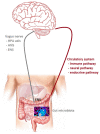The Microbiota-Gut-Brain Axis as a Key to Neuropsychiatric Disorders: A Mini Review
- PMID: 34682763
- PMCID: PMC8539144
- DOI: 10.3390/jcm10204640
The Microbiota-Gut-Brain Axis as a Key to Neuropsychiatric Disorders: A Mini Review
Abstract
The central nervous system (CNS) is closely related to the gastrointestinal tract, mainly through regulating its function and homeostasis. Simultaneously, the gut flora affects the CNS and plays an essential role in the pathogenesis of neurologic and neuropsychological disorders such as Parkinson's and Alzheimer's disease, multiple sclerosis, amyotrophic lateral sclerosis or autism spectrum disorder. The population of gut microorganisms contains more than one billion bacteria. The most common are six phyla: Proteobacteria, Actinomyces, Verucomicrobia, Fusobacteria, and dominant Bacteroides with Firmicutes. The microbiota-gut-brain axis is a bidirectional nervous, endocrine, and immune communication between these two organs. They are connected through a variety of pathways, including the vagus nerve, the immune system, microbial metabolites such as short-chain fatty acids (SCFAs), the enteric nervous system, and hormones. Age, diet, antibiotics influence the balance of gut microorganisms and probably lead to the development of neurodegenerative disorders. In this article, a review is presented and discussed, with a specific focus on the changes of gut microbiota, gut-brain axis, related disorders, and the factors that influence gut imbalance.
Keywords: gut microbiota; neurological disorders; psychiatric disorders.
Conflict of interest statement
All authors declare no conflict of interest.
Figures

References
-
- Dominguez-Bello M.G., Costello E.K., Contreras M., Magris M., Hidalgo G., Fierer N., Knight R. Delivery mode shapes the acquisition and structure of the initial microbiota across multiple body habitats in newborns. Proc. Natl. Acad. Sci. USA. 2010;107:11971–11975. doi: 10.1073/pnas.1002601107. - DOI - PMC - PubMed
Publication types
LinkOut - more resources
Full Text Sources

